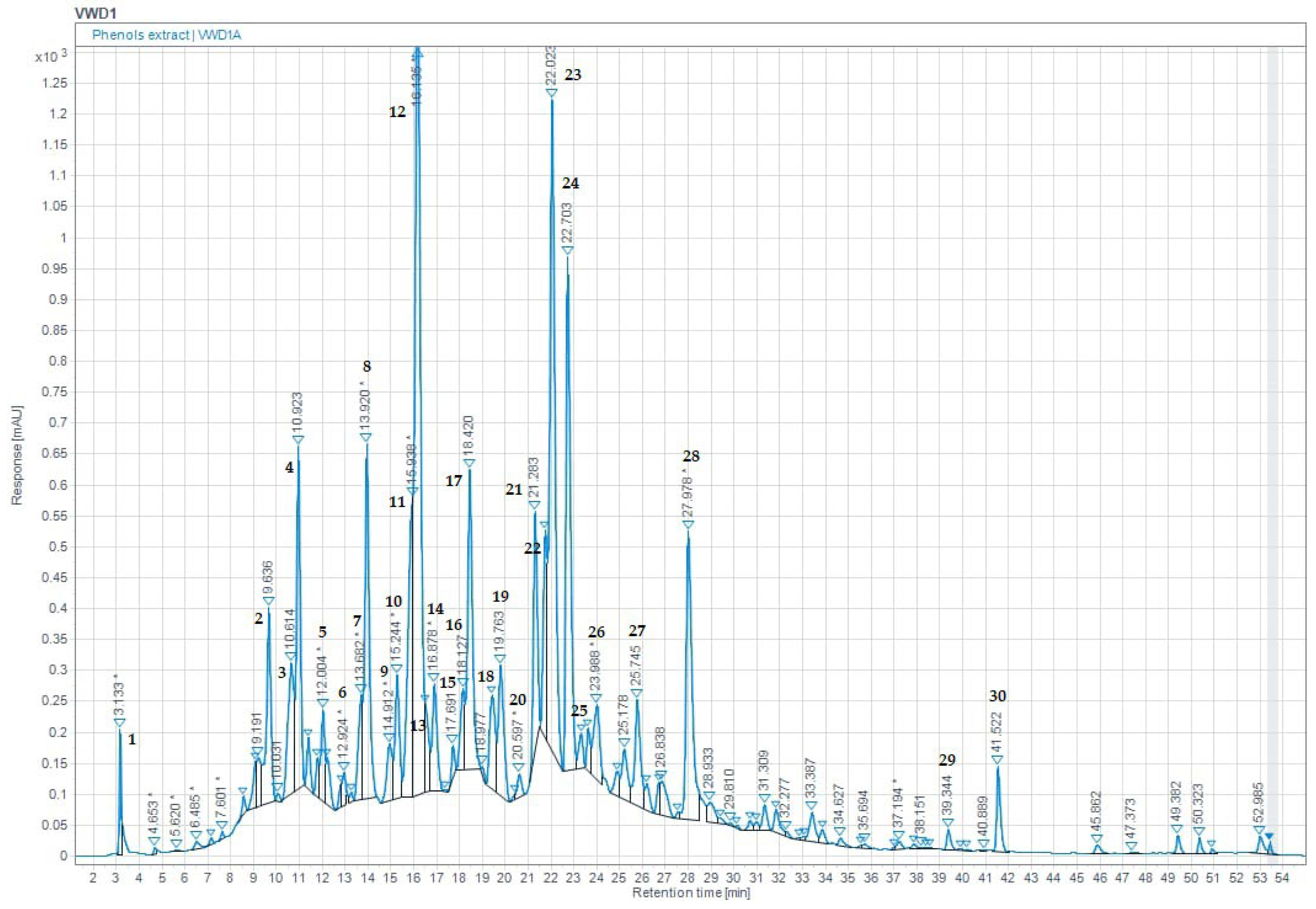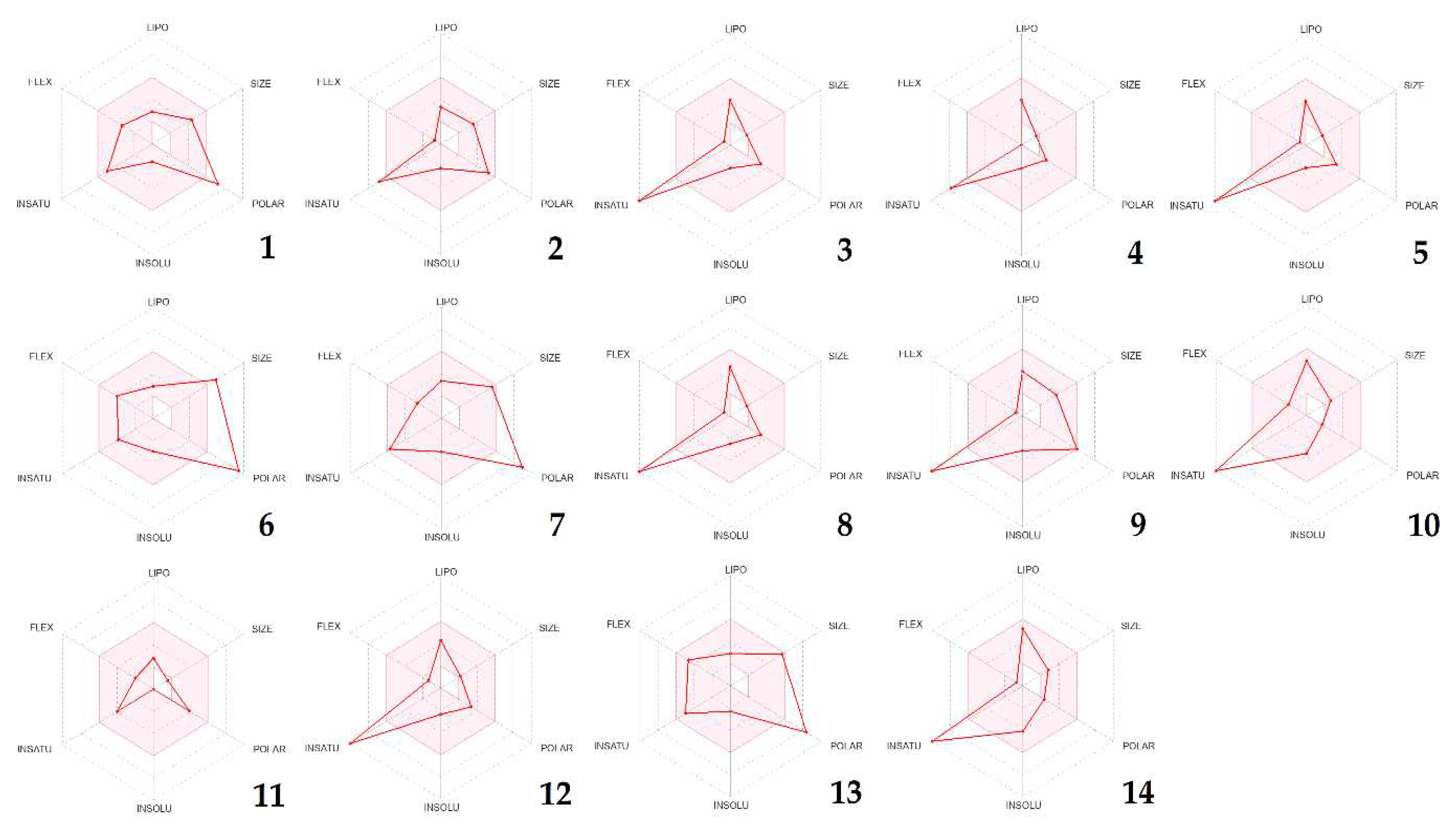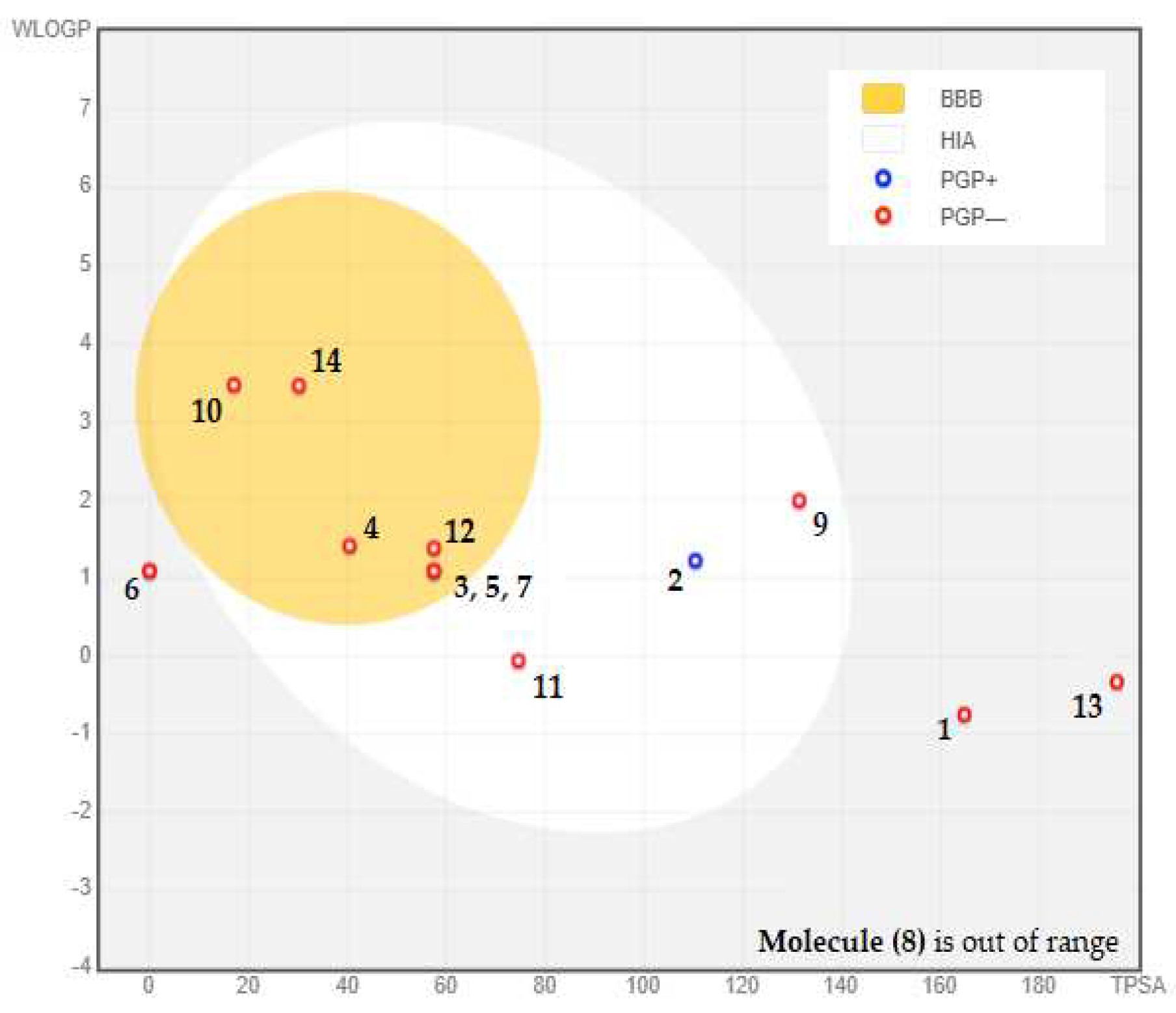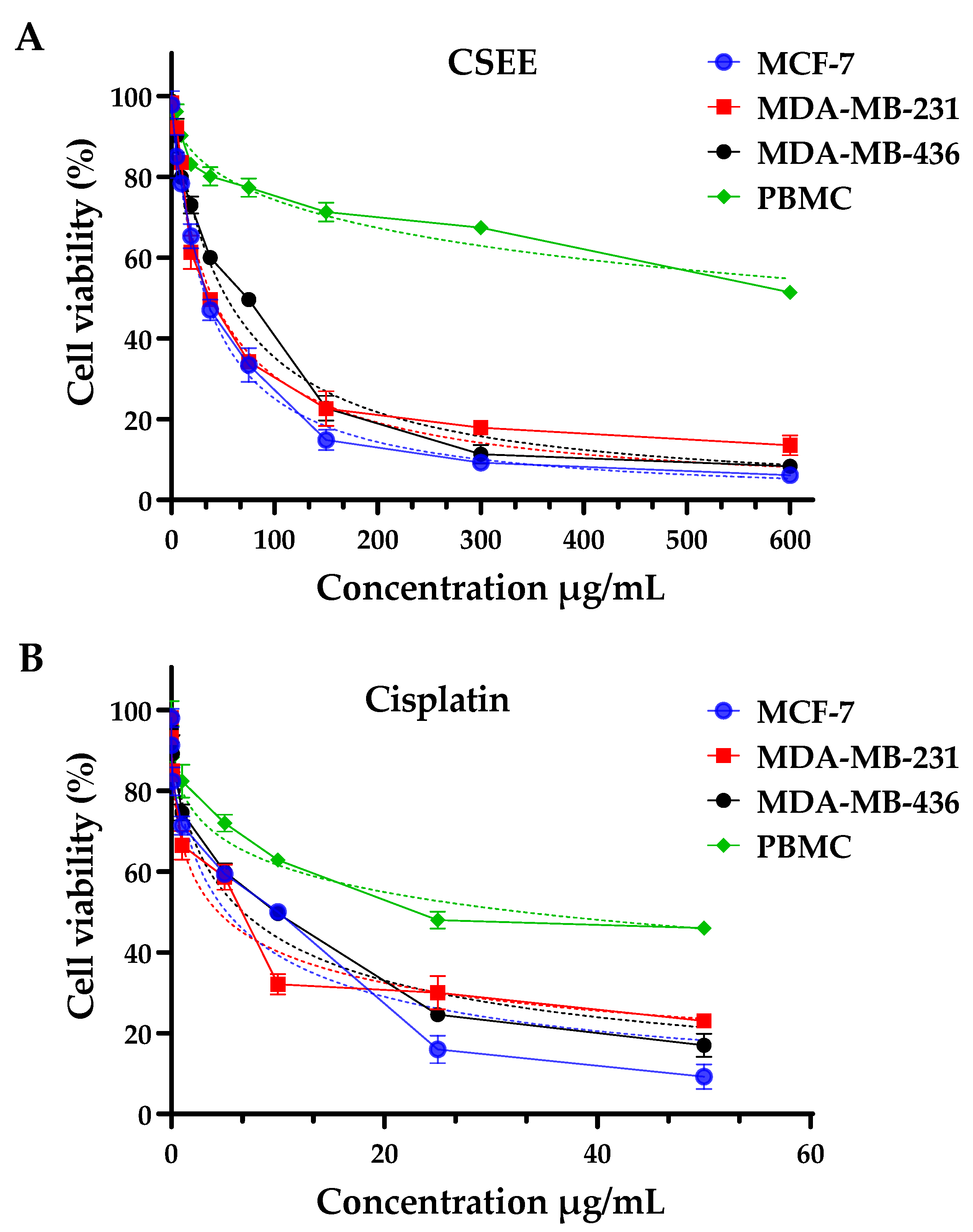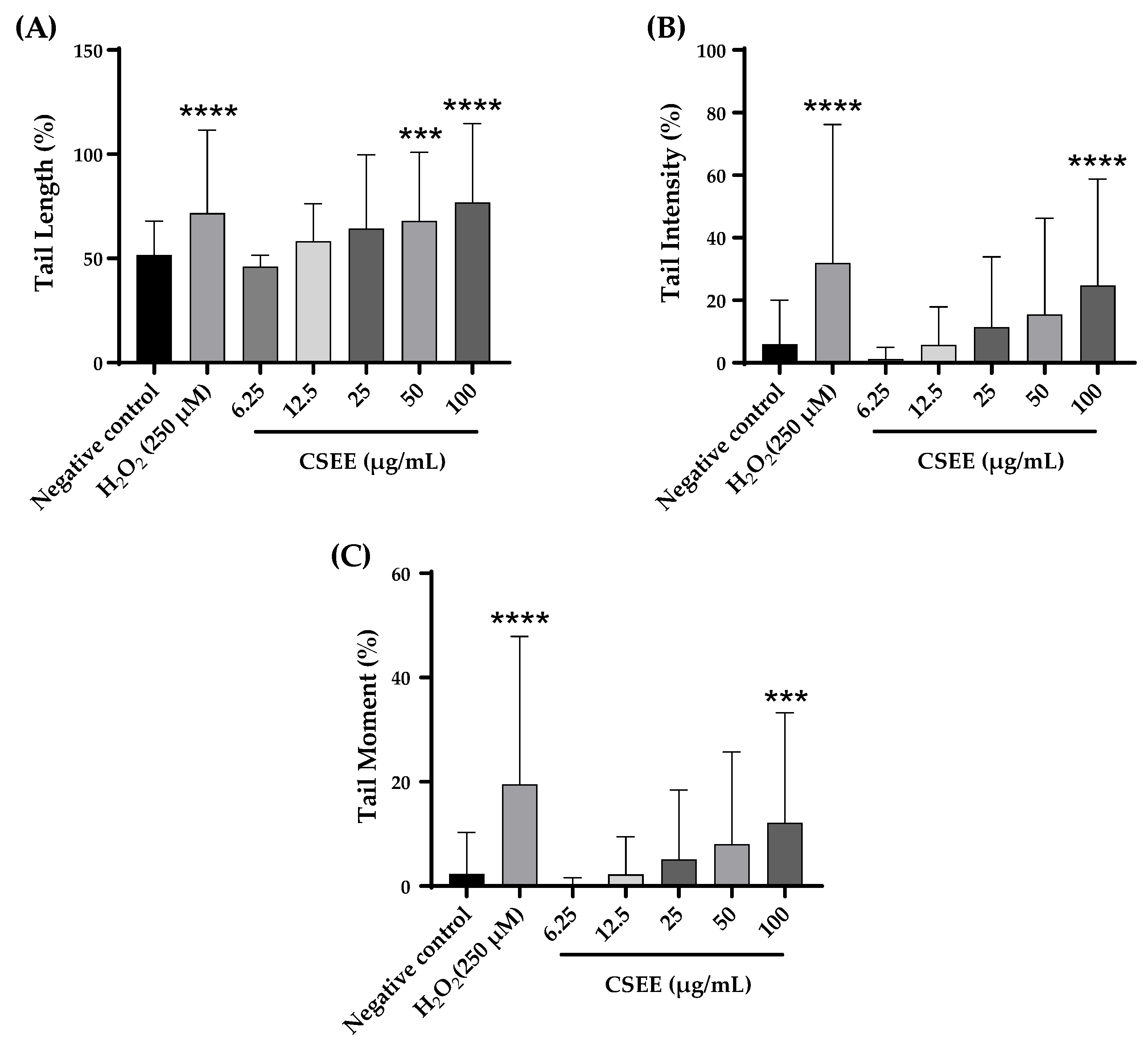2.1. Phytochemical Analysis Using HPLC-DAD
In our study, we utilized phytochemical analyses to evaluate the chemical composition of ethanolic extracts of carob using HPLC-DAD technique (
Figure 1 and
Table 1). Each HPLC/UV profile was conducted at 280 nm, and the analysis detected 20 peaks. Our findings indicated that the main substances found in the extracts were naringin, succinic acid, 2-hydroxycinnamic acid, flavone, phloridzin dihydrate, 3-hydroxybenzoic acid, orcinol, and syringic acid. Naringin, which belongs to the flavanone’s derivatives, was the most prevalent compound at 17.54%, followed by succinic acid at 12.07% and 2-hydroxycinnamic acid at 8.31%. Flavone was the most prominent compound detected for the flavonoid profile at 6.23%, followed by quercetin 3-
O-β-D-glucoside at 2.58%. Our analysis also detected kaempferol in the extract at 1.65%, while chalcone was present in modest concentrations.
Several studies have identified the principal phenolic compounds present in carob extracts, but their levels vary. A previous study by Eldahshan, (2010) [
22], has reported the presence of gallic acid, quercetin 3-
O-β-D-glucoside (isoquercetin), kaempferol 3-
O-α-L-rhamnoside (afzelin), quercetin 3-
O-α-L-rhamnoside (quercitrin), 1,2,6 tri-
O-galloyl-β-D-glucopyranose, (-)-epigallocatechin-3-
O-gallate, kaempferol, and quercetin in the ethanolic extract of carob leaves. Similar compounds have been previously reported in carob pods and derived products. For instance, Goulas et
al. (2019) [
23], found that gallic acid and rutin were the major phenolic compounds detected in carob powder. These findings suggest that carob extract could potentially have various therapeutic applications. The detection of naringin as the most abundant constituent in our extract is significant, given its link to various health advantages, such as anti-inflammatory and antioxidant effects [
24,
25]. Similarly, the detection of quercetin and kaempferol in our extract suggests that carob may also have potential anti-cancer properties, as these compounds have been shown to have anti-cancer effects [
26,
27,
28,
29,
30,
31].
2.3. Physiochemical and Pharmacokinetic Properties (ADME) of CSEE
Table 3 presents the physiochemical and drug-likeness analysis of 14 major compounds found in CSEE. The analysis includes parameters such as Hydrogen-Bond Donors (HBD), Hydrogen-Bond Acceptors (HBA), Topological Polar Surface Area (TPSA), distribution coefficient (Log Po/w), and solubility (Log S). Additionally, the Lipinski’s Rule of Five and Veber filter were applied to assess drug-likeness. The results indicate that all 14 compounds have moderate to high solubility (+++ to +) and adhere to Lipinski’s Rule of Five and Veber filter requirements. Overall, the majority of the compounds exhibit good solubility and moderate to high BBB permeability, indicating that they can easily cross the blood-brain barrier. All but three compounds (naringin, salicylic acid, and phloridzin dihydrate) comply with Lipinski's Rule of Five. These compounds have violations related to molecular weight, the number of oxygen atoms, and the number of hydrogen-bond donors, respectively. The compounds with the highest potential drug-likeness score are catechin
(2), 4-hydroxybenzoic acid
(3), orcinol
(4), quercetin
(9), and chalcone
(10). The results suggest that these compounds have potential therapeutic applications due to their physiochemical properties and adherence to drug-likeness criteria. Nonetheless, additional
in vitro and
in vivo investigations are imperative to verify their effectiveness and safety.
Table 4 presents the pharmacokinetic properties (ADME) of 14 of the most abundant compounds in CSEE extract. The parameters are categorized into four groups: absorption parameters, distribution parameters, metabolism parameters, and excretion parameters. The bioavailability score, predicts the fraction of an orally administered compound that reaches systemic circulation. The bioavailability score ranges from 0 to 1, and a score closer to 1 indicates better bioavailability [
37]. Among the identified compounds, it was found that 4-Hydroxybenzoic acid, 3-Hydroxybenzoic acid, Quercetin 3-
O-β-D-glucoside, Quercetin, Chalcone, Succinic acid, 2-Hydroxycinnamic acid, and Flavone have good bioavailability scores (≥ 0.55). Caco-2 Permeability, predicts the intestinal permeability of a compound using the Caco-2 cell model [
38]. The value of Caco-2 permeability ranges from -2 to 2, and a higher value indicates better intestinal permeability. Among the identified compounds, Orcinol, 3-Hydroxybenzoic acid, Quercetin 3-
O-β-D-glucoside, Quercetin, Chalcone, Succinic acid, 2-hydroxycinnamic acid, Phloridzin dihydrate, and Flavone have good intestinal permeability (≥ 1.0). For the Intestinal Absorption which is an important parameter that predicts the percentage of orally administered compound that is absorbed by the intestine. A higher value indicates better absorption. Among the identified compounds, Naringin, 4-Hydroxybenzoic acid, 3-Hydroxybenzoic acid, Quercetin 3-
O-β-D-glucoside, Quercetin, Chalcone, Succinic acid, 2-hydroxycinnamic acid, Phloridzin dihydrate, and Flavone have good intestinal absorption (> 70%).
The identified compounds were analyzed based on their distribution parameters. Log Kp (cm/s) was used to predict the ability of a compound to permeate biological membranes, and none of the identified compounds were found to have good membrane permeability. VDss was used to predict the volume of distribution of a compound in steady-state, and only Catechin and Salicylic acid showed good tissue distribution, with higher values indicating higher tissue distribution. The blood-brain barrier (BBB) permeability was utilized to anticipate the capacity of a compound to traverse this biological barrier, however, none of the identified compounds demonstrated favorable BBB permeability despite the BBB permeability value range of -3 to 3.
In order to anticipate the potential drug metabolism or toxicity of a molecule, it is important to examine its predicted activity and interactions with cytochrome P450 (CYP) isozymes. The activity of a molecule can refer to its effects on biological systems, such as its ability to bind to specific receptors or enzymes. Understanding how a molecule interacts with CYP isozymes, which are responsible for metabolizing many drugs, can provide important insights into its potential pharmacokinetic properties [
39]. None of the identified compounds are substrates for the cytochrome P450 (CYP) enzymes CYP2D6 and CYP3A4, which are responsible for metabolizing many drugs [
39]. Similarly, none of the identified compounds are inhibitors of the activity of CYP2D6 and CYP3A4 enzymes. The Renal Organic Cation Transporter 2 (OCT2) plays a key role in removing various drugs from the body through the kidneys. When a drug is a substrate for OCT2, it can be excreted more quickly through urine. Efficient renal clearance, facilitated by major organic cation transporters including Renal OCT2, is crucial for drug metabolism. However, none of the identified compounds have been found to be OCT2-substrates [
40]. In order to determine the total clearance of the compounds, both hepatic and renal clearance were measured [
41], and the results are presented in
Table 4. Overall, the table provides important information on the ADME properties of the identified compounds in CSEE extract, which can help in predicting their pharmacological activity and potential use in drug development.
To ascertain the plausibility of oral bioavailability of the recognized phytoconstituents, six physicochemical attributes were taken into account and represented via bioavailability radars. These properties included lipophilicity, size, polarity, solubility, flexibility, and saturation, each of which plays a crucial role in determining the ability of a molecule to be absorbed and utilized within the body. Bioavailability radars of the identified compounds are presented in
Figure 2, which provides an important visualization of their potential for oral bioavailability. The pink zone depicted on the radar denotes the region in which the molecule's graphical representation must fit entirely to be classified as drug-like. This is an important aspect to consider when evaluating the potential of a molecule to be used as a therapeutic drug, as it indicates the likelihood of the molecule being absorbed and distributed effectively within the body. In this case, all the physicochemical descriptors of the given phytoconstituents lie within the pink radar region of the bioavailability radar, except for insaturation in molecules 2, 3, 4, 5, 8, 9, 10, 12, and 14, which indicates that they may have too many double bonds or unsaturated groups in their chemical structures. Additionally, compounds 1, 6, 7, and 13 do not adhere to the polarity rule, implying that these compounds may be too polar to cross the lipid membranes in the gut and may thus have reduced bioavailability.
The BOILED-Egg model is a tool that allows for a preliminary assessment of a molecule's ability to be absorbed by the intestines and cross the blood-brain barrier. This is determined based on two key factors: lipophilicity, as measured by WLOGP, and polarity, as measured by TPSA [
42]. The resulting model is depicted visually, with the white area representing molecules that are more likely to be absorbed by the intestines, while the yellow area within the yolk represents molecules that are more likely to cross the blood-brain barrier [
42]. The dots in the diagram are color-coded to indicate whether a molecule is a substrate or non-substrate for P-glycoprotein. Substrates are shown in blue, while non-substrates are shown in red. In this case, seven phytocompounds (4-Hydroxybenzoic acid, Orcinol, 3-Hydroxybenzoic acid, Salicylic acid, Chalcone, 2-hydroxycinnamic acid, and Flavone) have been identified as having high levels of absorption and being able to cross the blood-brain barrier effectively. Moreover, the analysis revealed that all these compounds are non-substrates for P-glycoprotein, with Catechin (2), being the exception
Figure 3.
2.6. Experimental Validation of the Tested Biological Activities
Several methods were employed to evaluate the antioxidant potential of the compounds, which are primarily based on their ability to reduce and trap free radicals, serving as a measure of their antioxidant capacity. However, the mechanism of action of each antioxidant activity is classified quantitatively, depending on how the applied compounds halt chain-breaking reactions. The results of these evaluations were presented in
Table 7. According to the DPPH test, the CSEE extract was able to reduce the stable violet DPPH radical to yellow DPPH-H, with an IC
IC50 of 302.78 ± 7.55 µg/mL, indicating strong antioxidant activity. Despite this, when compared to the pure reference antioxidant ascorbic acid (260.24 ± 6.45 µg/mL), the tested samples showed even higher levels of antioxidant activity. The effectiveness of the CSEE extract in inhibiting lipid peroxidation activity was evaluated using the β-carotene bleaching test. The results indicated that the CSEE extract demonstrated strong antioxidant activity with an IC
50 value of 352.06 ± 12.16 µg/mL. Furthermore, it was observed that the CSEE extract exhibited a greater antioxidant activity compared to the standard Butylated hydroxytoluene (BHT), as indicated by a value of 29.23 ± 9.34 µg/mL.
In addition, ABTS assay was performed, where the ability of the extract to scavenging the ABTS•+. The CSEE extract exhibited a strong scavenging activity against ABTS radicals with an IC
50 value of 48.13 ± 3.66 µg/mL. However, this value being more important when compared to the pure reference antioxidant ascorbic acid (8.23 ± 0.97 µg/mL). Besides, results showed that the CSEE exhibited highest TAC with 165 ± 7.66 µg/mL. These findings were in accordance with previous studies [
44,
45,
46].
In general, the antioxidant activity of plant extracts is influenced by the interaction of all the chemical components present, which can either act together or in opposition to one another. Several studies have shown a correlation between the antioxidant capacity of plants and their content of polyphenols and flavonoids [
47,
48]. The current study found that the high antioxidant activity of
C. siliqua was due to its abundance of polyphenols and flavonoids. There was a positive correlation between the phenolic and flavonoid content and the DPPH activity. Flavonoids, in particular, with certain structures, can act as donors of protons or electrons, which explains their positive correlation with the antioxidant activity [
35,
49].
- b.
Antibacterial and Antifungal Properties of CSEE
The well diffusion technique was implemented to measure the inhibition zone diameters, whereas the microdilution method was employed to determine the MIC, MBC, and MFC of CSEE (
Table 8 and
Table 9). It has been suggested that plant extracts are considered active when their inhibition zone diameter is ≥ 10 mm [
50]. The plant extract was found to have antimicrobial activity against all tested bacterial and fungal strains with inhibition zones diameters ranging from 18 to 28 mm. The largest zone of inhibition (IZ = 28 mm) was noted in the case of
E. coli, whereas the smallest zone of inhibition (IZ = 18 mm) was observed in the case of
P. aeruginosa. According to the data, the microdilution results showed that CSEE exhibited an inhibitory effect against all the tested bacteria and moderated effect against fungal strains with MIC values of 0.35 μL/mL and 10 μL/mL for all tested bacterial and fungal strains respectively. Moreover, the results showed that the studied extract showed bactericidal and fungicidal potentials with MBC values ranging from 0.35 to 0.70 μL/mL and MFC values of 10 μL/mL. These results are in accordance with several investigations which reported that
C. siliqua extracts have a strong antimicrobial potential against a large range of microbes including multidrug-resistant bacteria and fungal strains [
51,
52,
53].
These results can be linked to the chemical composition of the CSEE that showed a high content of polyphenols. Indeed, antimicrobial potential of plant polyphenols has been widely investigated against human pathogens in order to develop new antimicrobials [
54]. Different mechanisms are suggested to explain the antimicrobial potential of polyphenols. Several studies reported that highly oxidized phenolic compounds exert a greater inhibitory effect on microorganisms. Moreover, it has been reported that phenolics may induce a loss of proteins functions by serving as a source of stable free radicals that bind with proteins in an irreversible way. Polyphenols can act via other mechanisms such as binding to adhesins located on the surface of the microbial cell, complexing with metal ions or interacting with some substrates, rendering them inaccessible for microorganisms [
55,
56]. Our findings showed that CSEE contains 29.61 ± 0.36 g CE/100 DW of condensed tannins. Several studies reported that tannins affect the membrane permeability and the increasing of tannins concentration is accompanied with a decreasing in the permeability of the membrane [
57]. In this respect, a recent study demonstrated that tannins engendered an aggregation and precipitation of
S. aureus cells, which consequently induced a decreasing in membrane permeability and a reduction of oxygen mass transfer into cells [
58]. Furthermore, the results the HPLC-DAD profile of CSEE showed that the majority compounds of the extract belong mostly to flavonoid (
Table 1). Indeed, flavonoids are known to possess strong antimicrobial potential by exhibiting protection against plant pathogens and as a result, they can exhibit efficacy in mitigation of human pathogens as well [
59]. Flavonoids exert their antimicrobial effect through various mechanisms including inhibition of cell envelop synthesis, inhibition of efflux pump, inhibition of nucleic acid synthesis, inhibition of virulence enzymes, inhibition of biofilm formation as well as membrane disruption [
60].
- c.
Cytotoxicity of CSEE Against Breast Cancer Cell Lines (MCF-7, MDA-MB-231, and MDA-MB-436)
C. siliqua, is a plant widely used in folk medicine for its bioactive properties, especially its polyphenols, which have been identified as having beneficial potential against human diseases such as cancer and metastasis [
61,
62]. Different extracts of
C. siliqua have been tested
in vitro against several tumor cells [
21,
63,
64,
65]. In our study, we investigated the cytotoxic power of CSEE against breast cancer (MCF-7) and the two metastatic adenocarcinoma lines (MDA-MB-231, and MDA-MB-436) using the MTT assay. Cisplatin was employed as a positive control.
Table 2 displays that the CSEE had varying levels of cytotoxicity against different cell lines. MCF-7 was found to be the most sensitive cell line with an IC
50 value of 32.44 ± 5.23 µg/mL, whereas MDA-MB-231 and MDA-MB-436 were less sensitive with IC
50 values of 40.05 ± 3.21 µg/mL and 53.55 ± 5.35 µg/mL, respectively. Our findings were superior to those of Custódio et
al. (2011) [
63], who observed the effect of
C. siliqua extract on MDA-MB-231 and after 24 hours of incubation, a moderate efficacy was reported with an IC
50 level greater than 400 µg/mL..
The requirement to exhibit a minimal amount of cytotoxicity is due to the fact that PBMCs are the first normal cell populations to come into contact with anticancer medicines employed in conventional intravenous chemotherapy of patients. In fact, we used the MTT test to assess how CSEE affected the vitality of PBMCs. With an IC50 > 890 µg/ml, the results obtained indicated little cytotoxicity against PBMCs. As a matter of fac, in contract to cisplatin, CSEE has a greater cytotoxic effect on tumor cells than on PBMCs. These findings point to these compounds highly selective ability to destroy tumor cell lines while having no negative effects on normal cells. The results indicate that CSEE has a higher IC50 value (i.e., lower potency) than cisplatin in all three cancer cell lines, indicating that it is less effective in inhibiting cancer cell growth. However, the SI values of CSEE are higher than those of cisplatin, indicating that it is more selective in inhibiting cancer cells while having less effect on PBMC. This is a positive, and very promising finding, as it suggests that CSEE may have a more targeted and less toxic effect on cancer cells compared to cisplatin, which is known to have significant side effects.
- d.
Genotoxicity Evaluation of CSEE on Rat Leukocytes
The initial test performed to evaluate the health safety of a substance, medicine, or nutraceutical is commonly believed to be the genotoxicity test [
66]. One highly accurate and rapid microscopic technique for assessing DNA damage, including single and double strand breaks, oxidative damage, and DNA-protein interactions, in both prokaryotic and eukaryotic cells
in vitro and
in vivo, is the comet assay, also known as Single Cell Gel Electrophoresis (SCGE), which employs agarose microgel electrophoresis [
67,
68,
69,
70]. The alkaline form of the comet assay was developed especially for detecting single-strand breaks and alkali-labile sites [
71].
In terms of the impact on the proportion of DNA in the tail and the tail moment (as illustrated in
Figure 5, it was observed that the concentrations of 6.25, 12.5, 25, and 50 µg/ml of
C. siliqua ethanolic extract did not result in any DNA harm according to our findings. But, the 100 µg/ml concentration showed a significant genotoxic effect compared to the negative control. In summary, we can conclude that CSEE were genotoxic over a dose of 100 μg/mL. The extracts' mode of action is currently unknown. Numerous investigations have demonstrated that plant extracts can have pro- or anti-mutagenic and antioxidant or pro-oxidant effects, mostly dependent on the dose utilized [
72,
73]. Flavonoids have been shown to have multiple biological actions, demonstrating that they have the potential to be both mutagenic and protective at high doses [
73,
74,
75]. The extract's promutagenic action, which is reflected in its prooxidant activity in producing free radicals that damage DNA, may be influenced by high quantities of flavonoids in elevated concentrations of the extract. In addition, when flavonoids are present at higher concentrations, they may be causing damage to the genetic material by intercalating into DNA, inhibiting enzymes that are associated with DNA such as topoisomerase II, blocking important enzymes that are involved in hormone metabolism, and changing the behavior of other significant enzymes, which can lead to the production of clastogenic effects [
76,
77]. Several polyphenols and flavonoids, including vanillic acid, caffeic acid, chlorogenic acid, ferulic acid, and quercetin, are well-known antioxidants; yet, depending on the dose, they can also be prooxidants, which is why they are a substantial contributor to DNA damage [
78,
79,
80,
81,
82].
